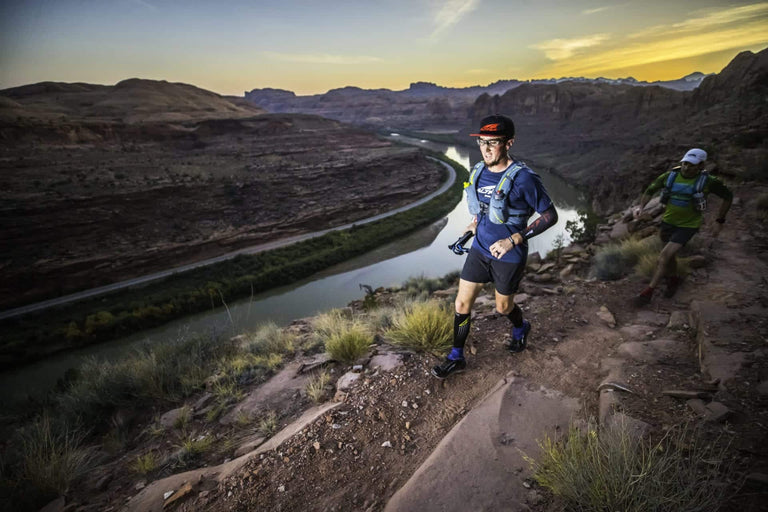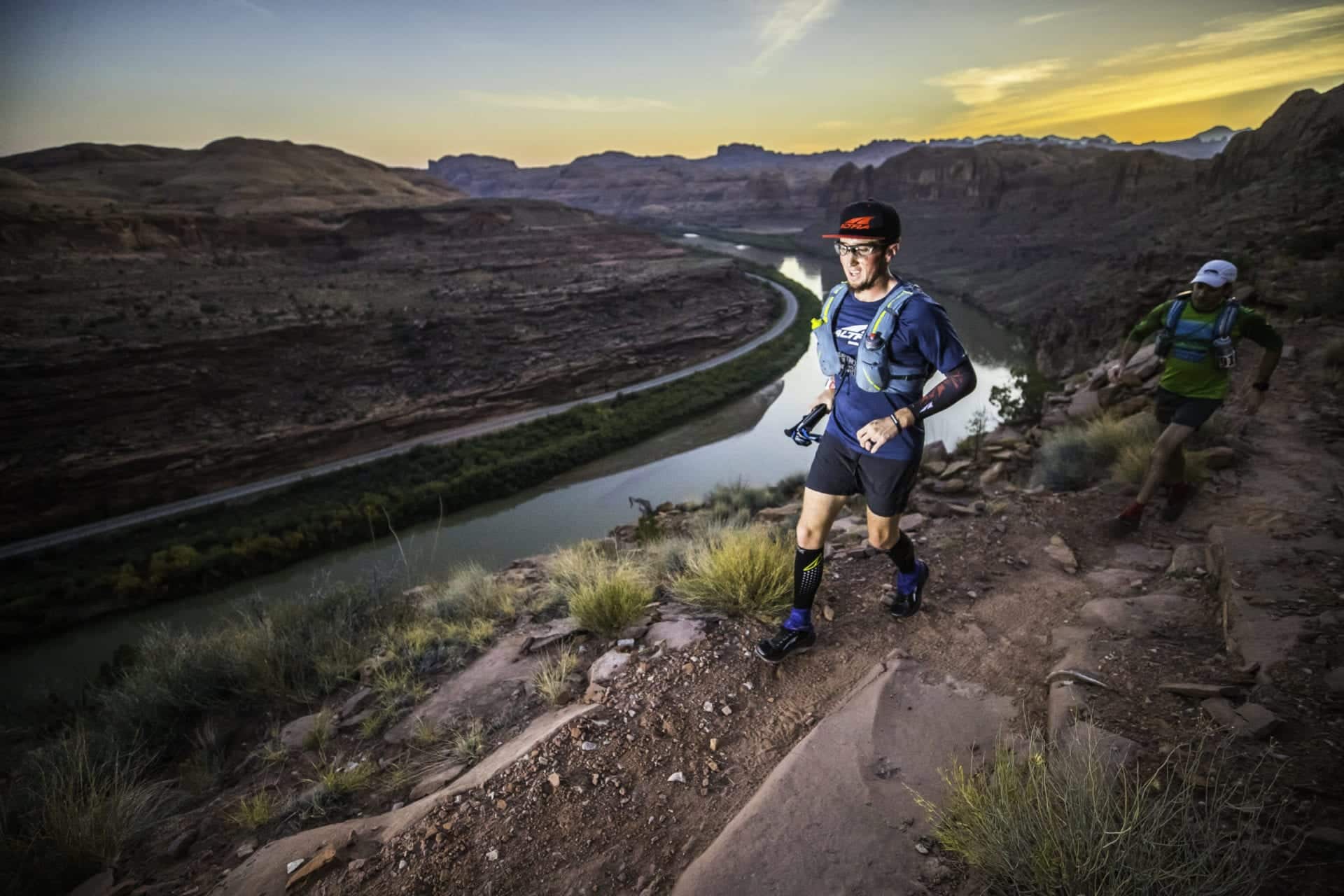On a cold February day in 2012, Mike McKnight’s running career was almost snuffed out before it got started.
Mike, then 21, and his friends were skiing at Beaver Mountain near Logan, Utah, and set up to hit a table-top jump in the terrain park, one Mike had hit multiple times in the past. But previously, Mike had carved his way into the jump, taking it at a conservative speed.
“I decided to go off of it skis pointing forward, as fast as I could, and see how far I could go.”
As soon as the jump ramped up, Mike realized “as fast as he could” was way too fast.
“I panicked, and foolishly I started leaning back to fall over,” he says. “I launched off and landed flat on my back.”
It was an icy day, and the impact was the equivalent of landing on concrete. Ski patrol rushed him to the base, where an ambulance was waiting to take him to the hospital, and the next day into surgery.
Mike had shattered his L1 vertabrae, and doctors inserted two metal rods and nine screws in his back, along with a piece of his hipbone that was grafted to his spine. Fortunately, Mike’s spinal cord hadn’t been damaged.

“The doctor told me that miraculously the vertebrae had burst away from my spinal column, but if I had landed a little differently and it had burst inwards, I would have been paralyzed,” he says.
He wouldn’t be paralyzed, but the doctor also told him he’d probably have to drop out of school for a couple of semesters, and that he’d more or less be in bed for months, aside from a prescribed one-mile walk each day with the assistance of a walker. He projected it would be a year before Mike could consider going for a run.
McKnight, at 29 already one of the top long-distance ultra runners in the country, grew up on a dairy farm in northern Utah’s Cache Valley. He was overweight as a child, and his life as a runner began simply to try and lose weight and avoid being teased as he transitioned to high school.
“I hated it,” he says. “It was always a chore because I was big and I was slow. Once I lost the weight, I’d rather just watch what I was eating. I didn’t really like exercise at all as a kid.”
It wasn’t until he was 21 that he actually took an interest in running, when his sister was signed up for a half marathon and encouraged Mike to join her. Without training much, he finished in just under and hour and a half.
A short time later, he ran a mile for time, clocking 4:54.
Maybe, he thought, if he trained hard, he stood a chance of walking on the track team at Utah State University, where he was attending college.
“I thought maybe I could get some of my schooling paid for,” he laughs. “That was a big part of what lit the spark.”
Over the next few months Mike began to train for the first time. Then came that February day at the ski hill, and his plans were sidetracked.
Though he spent much of the first few days after surgery sulking in bed, he was diligent about his daily mile, aided by a walker.

Two or three days post-op, “I decided to try and push my times,” he says.
His first mile took 45 minutes. He pushed that to 30 minutes.
“When I got to 20 minutes, I started doing two miles, then three miles,” he says.
Three weeks after surgery, he was walking six miles a day without any assistance, and a few days later, he eschewed the doctor’s grim prognosis and went for a half-mile run.
Six weeks after surgery, in a full turtle shell brace, he signed up for and ran a 10k.
“I still don’t think my surgeon knows, Mike says, “I never told him.”

While his return to activity felt somewhat miraculous, the gap between his prognosis and reality left him with quite a bit of time on his hands—after the accident, he lost his job and had his professors give him an incomplete in all his courses.
“I had months where I was just running,” he says, “10-plus miles everyday because I had nothing else to do.”
Running to this point had been all on roads, until he got a new job, where a co-worker, Cody Draper, introduced him to trail running.
“I invited him to do a 10k or something, and he told me he doesn’t really do anything under a marathon,” Mike says.
Draper was training for a 50-miler the next week, and a 100-mile race later that year. Before he even had the chance to sign up for any road races, Mike had fallen in love with trail running, and was training with and pacing Draper.
Just over a year after his accident, around the time that Mike’s surgeon told him he might be able to ease back into running, he ran his first ultra, the Logan Peak Trail Run, in June 2013.
“I jumped in pretty quick,” he says.
He signed up for a 50k in Wyoming, paced Draper in The Bear 100-miler, and signed up for the same race the following year. Between 2014 and 2016, he ran 13 ultras, three of them 100-milers. Though he raced a variety of distances, he noticed himself gravitate toward the longest races.
“It’s a weird thing, but the suffering, there’s something addictive about it.”
In 2016, a fellow ultrarunner who Mike knew won the fastest combined time for the Double Crown of 200’s—the Bigfoot 200 in Washington’s Cascade Mountains, and the Tahoe 200 in Lake Tahoe.
“I didn’t even know 200’s existed,” he says. “He and I had raced before, and we had done very similar, or I had done a bit better. It got me curious.”
These 200-mile races were a different breed—even in 100-mile races most competitors could finish the race in a push with maybe a short nap. But the 200-mile races were long enough that they required actual sleep, often at aid stations, as well as a much different approach to pacing and strategy.

Mike signed up for 2017 Bigfoot the following year with the intention of chasing the Double Crown record. But shortly after signing up, a third race was added to the series, the Moab 240. Now it was no longer the Double Crown, it was the Triple Crown, and it seemed a bit too much to bite off for someone who hadn’t even competed at that distance before.
“I just trained and went into the following year to do Bigfoot without signing up for the other two,” he says. “But I finished Bigfoot, and I enjoyed that suffering aspect.”
A week later, Mike had signed up for the other two races. That year, he was one of 13 people to complete the Triple Crown, and though he didn’t win any individual race, he still claimed the overall fastest combined time at 205:04:18.
He accomplished what he set out to do, but it hadn’t come easy.
“I had so many issues, it’s was honestly a terrible experience,” he says. “For Bigfoot, I puked for the first 100 miles. In Tahoe I had IT band issues and had to walk essentially half the race, and in Moab, at mile 200 I got a stress fracture in my foot.”
After still getting the fastest combined time despite all the problems, he knew he could improve the record. He took a break in 2018 and committed to the series for 2019, but his approach needed work.

He began strength training, which helped sort out his IT band issues. With the help of a coach, he overhauled his diet, switching to a low-carb, high-fat regiment that trained his body to burn fat during long races, and eliminated his stomach problems. He spent the first part of the year training for speed in preparation for the Western States 100, and after that race, he slowed down and spent the remaining weeks doing long hiking sessions that focused on volume.
Revising his mental approach, he asked his wife and crew not to tell him where he was in relation to his previous times so he could stay focused and motivated.
“I wanted to run according to how I felt,” he says. “I didn’t know until mile 180 at Bigfoot that I was ahead of course record pace.”
On October 13, 2019, he crossed the finish line at the Moab 240, winning the race and completing his second Triple Crown. This time, he took first in all three races, and cut an incredible 43 hours off his previous record.
Though he has no plans to try and best his record again, he’ll still be showing up on race day—he recently left his job at Altra Running to be a race director for Destination Trail, the company that puts on the Triple Crown, as well as a number of other trail races. He’s even begun work on a book about his experiences.
After Mike’s ski accident in 2012, as he lay in the hospital bed, the doctor told him, “Running will never be the same for you again.”
“If only he knew how right he was,” McKnight says.




